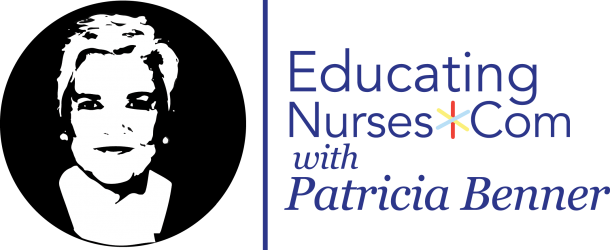by Patricia Benner, copyright 2015
Download PDF
- A Practice of Teaching Nursing that Brings Clinical Classroom Together.
- Unfolding Cases for Active Learning.
- For new teachers and those interested in developing more interactive classes.
________________________________________________________________________
Maxims for Excellence in Teaching
- Focus on learning and learning outcomes.
- Create curiosity, openness and passion for knowledge use in practice.
- Integrate “Knowing-about, Knowing-that”, and clinical practice implications of “Knowing-how, and -when.”
- Well designed, active engaged learning and problem solving in class creates high learning impacts!
- Create learning communities within the class or clinical experience.
- Create student engagement based on the significance of the topic while avoiding distracting entertainment.
- “Less is more” – create deep learning about the most important, enduring aspects of nursing practice.
_____________________________________________________________________
“Invisibility of the Student is the Greatest Learning Impediment”
Dr. Lee Shulman, President Emeritus, Carnegie Foundation for Teaching and Learning.
- Learning begins from the learner’s current situated understanding.
- Inquiry skills are essential to ongoing learning.
- Teach Concepts in a Range of Contexts and in differing levels of complexity.
- For Teaching Students to Think Like a Nurse, Teach for Recognizing the Nature of a Situation and a Sense of Salience for Particular Situations.
_____________________________________________________________________
Glossary: Stretch your Student’s Understanding of Thinking in Practice
Salience: defined as recognizing what’s most and least important in a clinical situation, is a form of “taken for granted” background understanding; a form of tacit knowledge essential for focusing on what matters most in clinical situations.
Clinical Imagination: The ability to be attuned to the needs, challenges and opportunities in a clinical situation so that the student responds to the patient’s concerns, and therapeutic needs.
Moral Imagination: Refers to how discerning and attuned the nurse is to recognizing when ethical standards are breached, or to imagining situated possibilities for reducing moral distress.
Experiential Learning: is defined, as a turning around of pre-understandings of the situation so that new understandings of the situation or nuances to the situation occur to the learner. (Hans Jorg Gadamer)
Situated Use of Knowledge or Situated Cognition refers to productive thinking in a specific clinical situation. This is more than mere application of knowledge about a technique or procedure. It refers to knowing what knowledge is relevant and what kinds of assessments, and interventions are required for the particular clinical situation.
_____________________________________________________________________
Learning Activities
Develop “Pat Cross Style One Minute Evaluation” questions tailored to your learning goals, at the end of class. For example:
- Identify key insights your gained today in class:
- How will these insights impact your practice?
- Did any of the topics discussed seem irrelevant to practice? If so, how?
- Identify any aspects of class that you like more clarification and explanation?
_____________________________________________________________________
Teacher Self-Evaluation Questions
- Please describe the strategies that you currently use to engage your students in active leaning in your classroom.
- What strategies do you use to understand your student’s learning styles, difficulties, past clinical and nursing experience? Please Describe.
- Please evaluate the amount of teacher talk, and student talk in your classroom.
- How often do students address one another’s questions and comments in your class?
- To what extent do you plan your questioning strategies in class? Evaluate the level of your questioning in terms of the thinking required.
- Do your questions generate more than yes and no responses?
- Do your questions require problem solving?
- Do you ask questions that are puzzling and require more inquiry and information currently available?
_____________________________________________________________________
Planning for Change
- It is not possible to change all aspects of your teaching all at one time.
- Identify one or two changes you plan to introduce into your teaching within the next month.
How will you evaluate the effectiveness of these changes?

